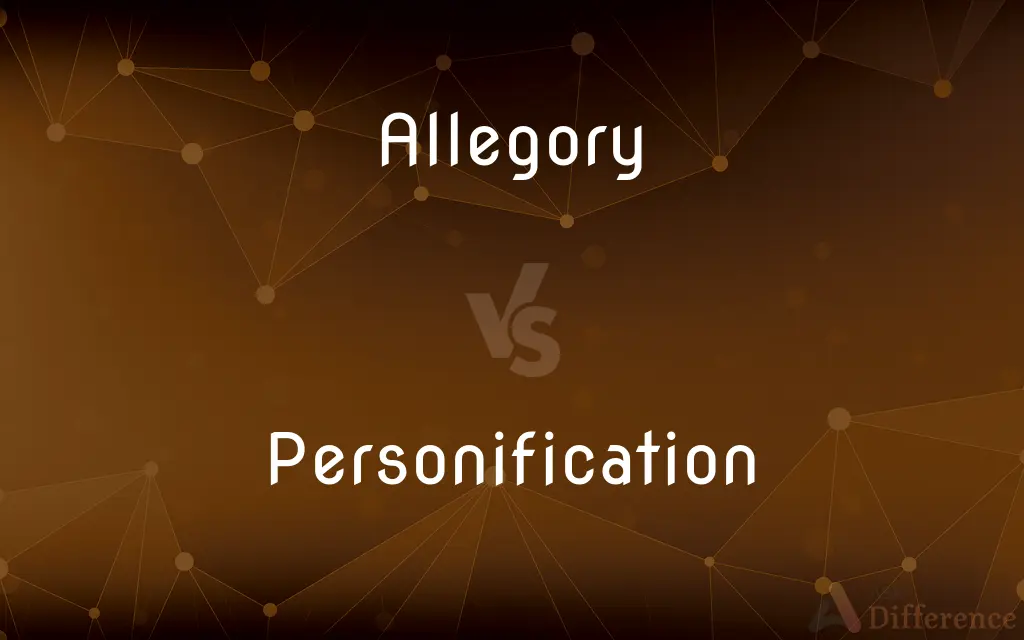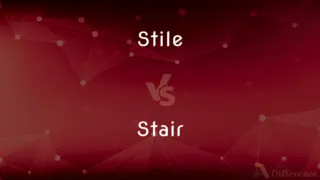Allegory vs. Personification — What's the Difference?
By Maham Liaqat & Fiza Rafique — Updated on April 3, 2024
Allegory is a narrative technique using symbolic figures to convey deeper meanings, whereas personification attributes human qualities to non-human entities.

Difference Between Allegory and Personification
Table of Contents
ADVERTISEMENT
Key Differences
Allegory is a storytelling or artistic device where characters, events, or settings represent abstract ideas, principles, or moral qualities, allowing for complex ideas to be conveyed with more tangible and relatable elements. On the other hand, personification is a figure of speech where non-human objects, animals, or concepts are given human characteristics, emotions, or behaviors, making them more relatable or vivid to the audience.
Allegories often encompass entire narratives, where every element serves a symbolic purpose, contributing to a broader, layered meaning. Whereas personification can occur in a single sentence or passage, bringing life to the inanimate and making descriptions more expressive and engaging.
While allegory aims to reveal a hidden, deeper moral, political, or philosophical message through its symbolic narrative, personification focuses on enhancing the reader's emotional connection and understanding of the text by imbuing abstract concepts or inanimate objects with human traits.
Allegories are primarily used in literature, art, and film to explore complex themes, societal critiques, or historical events indirectly, offering a veil of abstraction that encourages reflection and interpretation. Personification, however, is a common literary device found in poetry, prose, and everyday language, used to create vivid imagery and emotional depth.
In reading or analyzing allegorical works, the audience is invited to decode the symbolism to grasp the underlying messages or critiques presented. In contrast, personification enriches the immediate sensory experience of the text, making descriptions more lively and accessible without necessarily implying deeper layers of meaning.
ADVERTISEMENT
Comparison Chart
Definition
A narrative with symbolic figures and events representing deeper meanings.
Attribution of human qualities to non-human entities.
Purpose
To convey complex ideas, morals, or critiques indirectly.
To enhance emotional connection and imagery by making the non-human relatable.
Usage
Encompasses entire narratives or works.
Can occur in single sentences or passages.
Focus
Hidden, deeper messages or themes.
Vivid, engaging descriptions.
Common in
Literature, art, film.
Poetry, prose, everyday language.
Compare with Definitions
Allegory
A story where characters symbolize moral qualities.
In Animal Farm, the farm animals represent different figures from the Russian Revolution.
Personification
Giving human traits to animals or objects.
The wind whispered through the trees.
Allegory
Artistic representations where elements symbolize abstract concepts.
In the painting Justice, a blindfolded woman represents the impartiality of justice.
Personification
Using human characteristics to describe abstract ideas.
Justice turned a blind eye.
Allegory
A narrative technique conveying deeper messages through symbolism.
The Tortoise and the Hare teaches the moral that slow and steady wins the race.
Personification
Attributing emotions to nature.
The angry storm clouds gathered overhead.
Allegory
Films with underlying social critiques presented symbolically.
The Matrix serves as an allegory for escaping the illusions of a controlled reality.
Personification
Making inanimate objects perform human actions.
The clock stood watch over the room.
Allegory
Literature where the plot and characters have a secondary meaning.
The Lord of the Flies allegorically explores the dark side of human nature.
Personification
Describing concepts with human actions.
Time marches on.
Allegory
As a literary device, an allegory is a narrative in which a character, place, or event is used to deliver a broader message about real-world issues and occurrences. Authors have used allegory throughout history in all forms of art to illustrate or convey complex ideas and concepts in ways that are comprehensible or striking to its viewers, readers, or listeners.
Personification
The attribution of a personal nature or human characteristics to something non-human, or the representation of an abstract quality in human form
The book provides a sustained account of how literary personification works
Allegory
A story, poem, or picture that can be interpreted to reveal a hidden meaning, typically a moral or political one
Pilgrim's Progress is an allegory of the spiritual journey
Personification
A figure intended to represent an abstract quality
The knight is accompanied by two feminine personifications of vice
Allegory
The representation of abstract ideas or principles by characters, figures, or events in narrative, dramatic, or pictorial form.
Personification
The act of personifying.
Allegory
A story, picture, or play employing such representation. John Bunyan's Pilgrim's Progress and Herman Melville's Moby-Dick are allegories.
Personification
A person or thing typifying a certain quality or idea; an embodiment or exemplification
"He's invisible, a walking personification of the Negative" (Ralph Ellison).
Allegory
A symbolic representation
The blindfolded figure with scales is an allegory of justice.
Personification
A figure of speech in which inanimate objects or abstractions are endowed with human qualities or are represented as possessing human form, as in Hunger sat shivering on the road or Flowers danced about the lawn. Also called prosopopeia.
Allegory
(rhetoric) A narrative in which a character, place, or event is used to deliver a broader message about real-world issues and occurrences.
Personification
Artistic representation of an abstract quality or idea as a person.
Allegory
A picture, book, or other form of communication using such representation.
Personification
A person, thing or name typifying a certain quality or idea; an embodiment or exemplification.
Adolf Hitler was the personification of anti-Semitism.
Allegory
A symbolic representation which can be interpreted to reveal a hidden meaning, usually a moral or political one.
Personification
A literary device in which an inanimate object or an idea is given human qualities.
The writer used personification to convey her ideas.
Allegory
A category that retains some of the structure of the category of binary relations between sets, representing a high-level generalisation of that category.
Personification
An artistic representation of an abstract quality as a human
The Grim Reaper is a personification of death.
Allegory
A figurative sentence or discourse, in which the principal subject is described by another subject resembling it in its properties and circumstances. The real subject is thus kept out of view, and we are left to collect the intentions of the writer or speaker by the resemblance of the secondary to the primary subject.
Personification
The act of personifying; impersonation; embodiment.
Allegory
Anything which represents by suggestive resemblance; an emblem.
Personification
A figure of speech in which an inanimate object or abstract idea is represented as animated, or endowed with personality; prosopop ia; as, the floods clap their hands.
Allegory
A figure representation which has a meaning beyond notion directly conveyed by the object painted or sculptured.
Personification
A person who represents an abstract quality;
She is the personification of optimism
Allegory
A short moral story (often with animal characters)
Personification
Representing an abstract quality or idea as a person or creature
Allegory
A visible symbol representing an abstract idea
Personification
The act of attributing human characteristics to abstract ideas etc.
Allegory
An expressive style that uses fictional characters and events to describe some subject by suggestive resemblances; an extended metaphor
Common Curiosities
Can an allegory include personification?
Yes, allegories can include personification as part of their symbolic narrative.
What is personification?
Personification is a literary device where non-human entities are given human characteristics.
Is personification used only in literature?
While prevalent in literature, personification is also used in everyday language and various forms of art.
How does allegory differ from symbolism?
Allegory is a sustained narrative of symbolic figures and events, while symbolism involves specific symbols representing ideas or concepts within a narrative.
What makes personification effective in poetry?
In poetry, personification enriches imagery and emotional resonance, bringing abstract concepts to life.
What is an allegory?
An allegory is a narrative where characters and events symbolize deeper meanings, often moral, political, or social.
What is the purpose of personification?
Personification aims to make descriptions more vivid and emotionally engaging by attributing human qualities to non-human entities.
Can allegories be found in modern media?
Yes, allegories are present in modern literature, films, and even video games, offering insights into societal issues or human nature.
How does personification affect the reader?
Personification can enhance the reader's emotional connection and imagination, making the text more lively and memorable.
Why do authors use allegory?
Authors use allegory to explore complex themes and encourage readers to think critically about underlying messages.
Are allegories always easy to understand?
Allegories can be complex, requiring readers to interpret the deeper meanings behind the symbolic narrative.
How is personification used in everyday language?
Personification is used in idioms and expressions, such as saying "time flies" to describe the swift passage of time.
How does personification contribute to the thematic depth of a text?
Although primarily used for imagery, personification can also subtly contribute to a text's thematic depth by highlighting the connections between humans and the non-human world.
Can an entire book be an allegory?
Yes, entire books can be allegorical, with every element contributing to the overarching symbolic meaning.
What challenges do readers face when interpreting allegories?
Interpreting allegories can be challenging due to their layered meanings and the requirement to recognize and decode symbolism.
Share Your Discovery

Previous Comparison
Cotangent vs. Tangent
Next Comparison
Stile vs. StairAuthor Spotlight
Written by
Maham LiaqatCo-written by
Fiza RafiqueFiza Rafique is a skilled content writer at AskDifference.com, where she meticulously refines and enhances written pieces. Drawing from her vast editorial expertise, Fiza ensures clarity, accuracy, and precision in every article. Passionate about language, she continually seeks to elevate the quality of content for readers worldwide.
















































